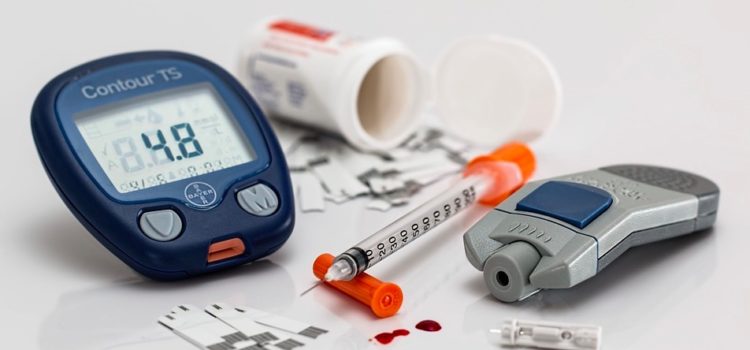

This article is an excerpt from the Shortform book guide to "How Not to Die" by Michael Greger. Shortform has the world's best summaries and analyses of books you should be reading.
Like this article? Sign up for a free trial here .
What causes diabetes? How does diabetes develop in the body?
Diabetes is a chronic condition associated with abnormally high levels of glucose in the blood. Insulin produced by the pancreas lowers blood glucose. Absence or insufficient production of insulin, or an inability of the body to properly use insulin causes diabetes.
Keep reading to learn about the two types of diabetes, causes, and prevention methods.
Type 1 and Type 2 Diabetes
Diabetes mellitus is a condition in which blood sugar levels are chronically elevated.
High blood sugar damages nerves, leading to neuropathy and pain. It also damages blood vessels, which 1) leads to blindness and 2) cuts off circulation in the extremities, leading to amputation of limbs.
There are two major types of diabetes. Both types concern insulin, the hormone that causes cells to absorb glucose from blood. Diabetes causes and prevention measures will depend on the type of diabetes as per your diagnosis.
- Type 1 diabetes is genetic and caused by autoimmune destruction of beta cells. Less insulin production means higher blood sugar. Type 1 diabetes can be treated with insulin injections.
- Type 2 diabetes is caused by insulin resistance. Insulin secretion can be normal or elevated, but insulin doesn’t work as effectively as normal, leaving sugar in blood. This is treated with drugs and sometimes with insulin.
Prediabetes in children is increasing because of obesity. Developing diabetes in childhood cuts life expectancy by 20 years and increases the risk of disease across the board.
Insulin Resistance and Fat
Fat is heavily associated with insulin resistance. 90% of type 2 diabetics are overweight.
- The biological mechanism: fat disrupts the insulin signaling pathway.
- Obese patients have about 2-5x the level of free floating fat in the bloodstream compared to people of normal weight. Obese people are basically spilling fat into the bloodstream constantly.
A person’s diet affects fat levels and insulin resistance, even controlling for the person’s weight.
- A 1927 study put people in two groups: Group 1 had a fat-rich diet, while Group 2 had a carb-rich diet. In high-fat Group 1, insulin resistance increased within days, far more than high-carb Group 2.
- People eating low-carb, high-fat diets can reach the same free floating fat levels as obese people.
Vegetarian Diet and Diabetes
Vegetarians have a 61% lower prevalence of diabetes compared to non-vegetarians.
- It’s not just because they’re skinner—even after controlling for weight, vegans have a <50% risk of diabetes compared to omnivores. Between people of the same weight, vegans have less fat trapped in deep calf muscles compared to omnivores
- Plant-based diets improve reduce insulin resistance, improve blood sugar control, and reduce LDL cholesterol.
Vegetarian diets have multiple effects that lower the risk of diabetes.
- Eating fewer calories: people tend to eat the same volume of food per meal, regardless of calorie count. Vegetables are calorically far less dense but feel more filling.
- Insulin sensitivity: even without causing weight loss, plant-based diets improved insulin sensitivity and A1C levels in diabetics, within weeks.
- Better eating habits: the plant-based diet group felt less likely to binge and felt less hungry.
- Intrinsic benefits of plant foods: eating five cups of legumes each week had better effects on cholesterol and insulin regulation than cutting 500 calories a day.
- Saturated fats in meat vs unsaturated fats in vegetables.
- Saturated fats like palmitate cause a variety of bad effects: toxic byproducts like free radicals, inflammation, and mitochondrial dysfunction.
- Unsaturated fats are less harmful, easier to detoxify, and may suppress inflammation.
- Saturated fats and LDL cholesterol are toxic to beta cells; monounsaturated fats are not.
- Lower potentially toxic chemicals: PCBs in salmon and canned sardines can disrupt metabolism. People with the highest level of pollutants have 38x the odds of diabetes.
- Higher resting metabolism: vegetarians have higher gene expression of carnitine palmitoyltransferase, which helps metabolize fats.
- Better mood: plant-based group reported better quality of life and higher mood scores than conventional diet.
- Reduces neuropathy pain and can restore vision loss.
While the risk of disease scales with the amount of meat you eat, even a little meat-eating is destructive.
- In Taiwan, people’s diet includes little meat to begin with—women ate a single serving each week, and men had a serving every few days. Vegetarian men had half the odds of diabetes as occasional meat eater. Vegetarian women had 25% the odds.
- Meat consumption was associated with weight gain, even after adjusting for calories. In other words, even when eating the same number of calories, meat eaters tend to gain more weight.
- Specifically, an increase in meat intake of 250g per day (like one steak) leads to a 2-kg higher weight gain after 5 years (Source).
- Poultry is potentially the most fattening meat—people eating 1oz of chicken a day had a significantly greater gain in BMI than non-chicken eaters. This could be caused by industries fattening chickens over time—100 years ago, a serving of chicken may have 16 fat calories; now, it has over 200 fat calories.
Other Interventions on Diabetes
Drugs are commonly prescribed to treat diabetes, but they can increase mortality.
- A seminal NEJM study showed that intensive blood sugar management by drugs led to increased mortality compared to standard therapy. The intensive group had a lower H1AC target and were subject to more drugs and higher doses.
- Insulin administered as a drug can accelerate aging and promote inflammation in arteries.
Gastric bypass surgery reduces diabetes in up to 83% of patients. This is great, but the same effect can be achieved with extreme diets, without the surgery: within a week of eating 600 calories daily, blood sugar levels normalize.
- Hypothesis: during extreme diets, fat is pulled out of fat storage in muscles and liver, allowing normal function of those organs.

———End of Preview———
Like what you just read? Read the rest of the world's best book summary and analysis of Michael Greger's "How Not to Die" at Shortform .
Here's what you'll find in our full How Not to Die summary :
- The health benefits of a plant-based, whole-food diet
- How to reduce your risk of developing the most common diseases that can kill you
- The 12 foods you should eat daily to maximize health benefits






